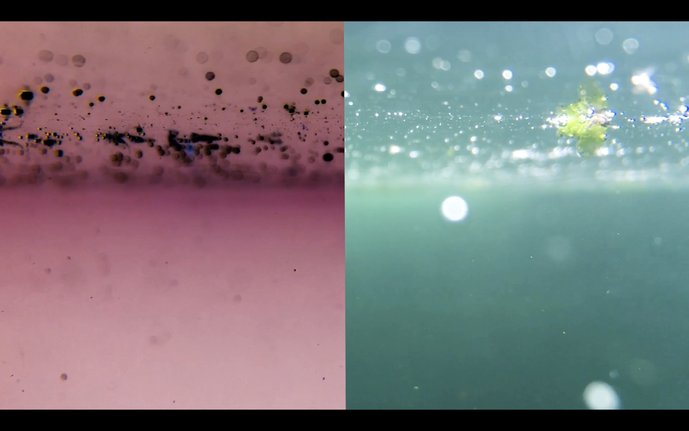

Isabella Münnich, “Sensing Underware” (2019), video, audio, interactive installation (© Isabella Münnich)
Extending the notion of “kollektiv, kollaborativ, kooperativ,” the artworks by Isabella Münnich, Vanessa Bosch, Christopher von Frankenberg and Janis Zeckai aim at building “techo-ecological” perspectives, exploring collaboration and communication capabilities between the human and non-human (worlds and species).
The students of the Techno-Ecologies seminar by guest professor Rasa Smite, throughout the Spring and Summer 2019 performed field studies experimenting with sensing, listening and visualizing, in order to reveal the complex relationship between technologies and ecology, nature and infrastructure, human and non-human worlds.
Ecology and our relationship with nature plays an important role today in post-media art practices as it often uses ideas from open cultures about sharing resources and tackling social issues through participatory and social mechanisms, as well as addressing issues such as renewable energy, sustainability, biodiversity, or interspecies relations. In addition to Felix Guattari's proposed Three Ecologies – environmental, social and mental (subjective) – emphasis can be laid on the Fourth – the “non-human” ecology (Donna Haraway, Eric Kluitenberg, etc.).
By combining the artistic with the social and the natural, the scientific and the emotional, the sensory with the actual, the students developed immersive artworks, proposing their visions of extending our collaboration capabilities towards human and non-human communication.
Sensing Underwater – the artistic research project by Isabella Münnich is based on the captivating behavior of living deep sea organisms and how they communicate through light. By performing the field studies in the lakes and ponds near Karlsruhe, experimenting with contact mic recordings and shooting videos under water, the artist aims to explore the communication patterns of underwater life and to transform them into an interactive sensory experience.
In reference to Donna Harraway's concept of “non-human ecology” and "making kin" as a way to communicate and intersect with multiple species, Vannessa Bosh created Coral Bank, addressing the issues of marine ecology. As a point of departure, the artist uses field studies of the aquariums in the Natural History Museum and of freshwater sites in Karlsruhe, reconsidering the relations between microplastic pollution and invasive plants and focusing on the coral as a living organism. Due to their inter-species nature – neither plant, nor animal – it represents artificial wilderness and cyborg nature.
Christopher von Frankenberg’s multi-channel immersive sound installation Reinhafen Soundscape Adventure-Time uses field recordings mixed with generated sounds, exploring the relations between the natural and the digital.
Another immersive experience by Janis Zeckai is his 360-degree video piece Domain.-esque. The artwork is an investigative study into the process of adaption within the systems and their continuously changing environmental properties. Panoramic video footage from narrow enclosed spaces are complemented with sounds from field recordings, referencing his sensual experience from childhood memories of vast spaces and closeness to nature. By means of contrasting experiences, the artwork aims to blur the boundaries between the visual and the audible, arguing that it is merely an interchangeable construct and claiming that the relationship between the natural and artificial phenomena must be holistically redefined.
The artworks are the result of the “Techno-Ecologies” seminar by Rasa Smite, guest professor at HfG. Dr. Smite is an artist and researcher, working with science and emerging technologies, founding director of RIXC Center for New Media Culture in Riga, Latvia (rixc.org, smitesmits.com)
Contact: gro.cxir(ta)etims.asar